Search results for: 'Artefakte'
-
 50 Artefakte der Michelsberger Kultur aus Museumsbestand
50 Artefakte der Michelsberger Kultur aus MuseumsbestandFunde vom Camp-a-Cayaux, bei neolithischer Flintmine in Spiennes, Belgien. Abschläge und Werkzeuge. 4500 v. Chr. bis 3500 v. Chr.
Price: on request Bronze pin from Iron Age Luristan
Bronze pin from Iron Age LuristanThree decorative spheres form an elegant pin head. Colourful bronze patina.
Price: on request Bracelet from Luristan with triangular terminals
Bracelet from Luristan with triangular terminalsThe bronze braclet is band shaped and has linear engravings on the outer side. Late Iron Age.
Price: on request Silver pin from Luristan
Silver pin from LuristanIron Age silver pin with attractive engravings. Nice dark patina.
Price: on request Bracelet from Luristan with triangular terminals
Bracelet from Luristan with triangular terminalsThe bronze braclet is band shaped and has linear engravings on the outer side.
Price: on request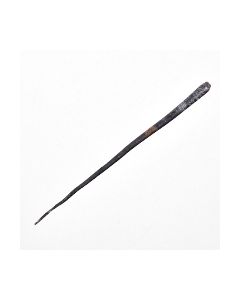 Pin from Luristan
Pin from LuristanIron Age silver pin with attractive engravings. Nice dark patina.
Price: on request Pin from Luristan
Pin from LuristanIron Age bronze pin with thick head. Green patinated metal.
Price: on request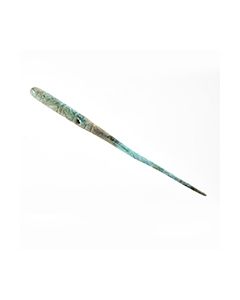 Bronze pin from Luristan
Bronze pin from LuristanLovely bronze pin from the early Iron Age. The head is decorated by engraved lines and a geometric knob.
Price: on request Pin from Luristan
Pin from LuristanIron Age silver pin with attractive engravings. Nice dark patina.
Price: on request Lorestanischer Keramikkrug
Lorestanischer KeramikkrugGroße Keramik aus Lorestan. Einhenkliger Krug von eleganter Form. Über 20cm hoch. 1500 bis 500 v. Chr., Späte Bronzezeit bis Eisenzeit.
Price: on request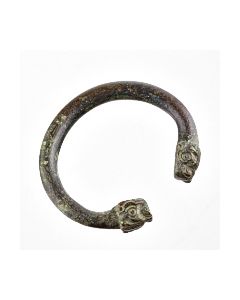 Bracelet from Luristan with lion terminals
Bracelet from Luristan with lion terminalsBronze braclet in perfect condition with beautiful dark patina. The terminals are stylized lion heads.
Price: on request Decorative pin from Luristan
Decorative pin from LuristanThe pin head is shaped like an open basket with a decorative knob. Bronze with attractive patina.
Price: on request Luristan silver bracelet with interesting decoration
Luristan silver bracelet with interesting decorationThe bracelet is massive yet elegant. Crossed lines and open circles are engraved on its surface. It is a beautiful piece from the Iron Age of Luristan.
Price: on request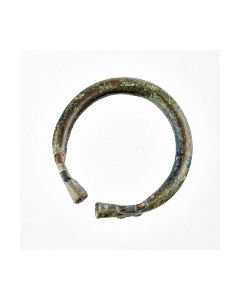 Bracelet from Luristan with animal terminals
Bracelet from Luristan with animal terminalsA high degree of abstraction for the animal heads and a wonderful blue patina make this piece a highlight for Iranian bronze works.
Price: on request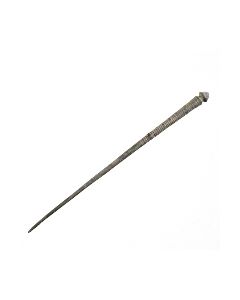 Bronze pin from Luristan
Bronze pin from LuristanLovely bronze pin from the early Iron Age. The head is decorated by engraved lines and a geometric knob.
Price: on request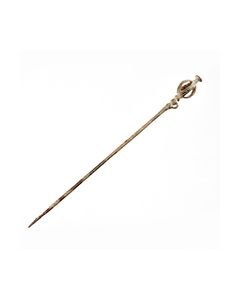 Large decorative pin from Luristan
Large decorative pin from LuristanThe pin head is shaped like an open basket with a decorative knob. Bronze with attractive patina.
Price: on request Lorestanische Keramikamphore
Lorestanische KeramikamphoreGroße Keramik aus Lorestan. Amphore mit Ritzdekor. 18,5cm hoch. 2000 bis 500 v. Chr., Mittlere Bronzezeit bis Eisenzeit.
Price: on request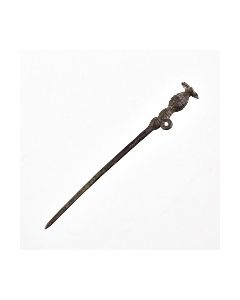 Luristan pin with floral decoration
Luristan pin with floral decorationWell preserved piece that impressively demonstrates the high quality of Luristan metal works.
Price: on request Gruppe 5 antiker Gürtelschnallen
Gruppe 5 antiker GürtelschnallenRömische Gürtelschnallen aus Bronze. Etwa 1. bis 6. Jh. n. Chr., diverse Ausführungen. Pannonische Provinzen.
Price: on request Massive bracelet from Luristan
Massive bracelet from LuristanThe bracelet has an interesting decoration on the outer side. It is a heavy and impressive bronze object.
Price: on request Pair of earrings from Luristan
Pair of earrings from LuristanThe earrings date to the early Iron Age of Luristan. The type of jewellery is rare for this region.
Price: on request Pair of pins with chain
Pair of pins with chainThe pair of pins dates to the early Iron Age of Luristan. It is made from Bronze and Iron. This state of preservation is extremely rare for composite objects.
Price: on request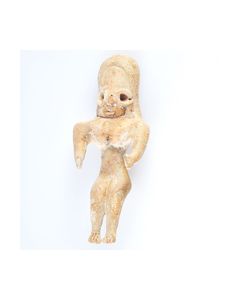 Idol der Harappa-Kultur
Idol der Harappa-KulturSehr rares Zeugnis einer der ältesten Stadtkulturen der Menschheit. Keramik-Figur einer Göttin, um 2000 v. Chr.
Price: on request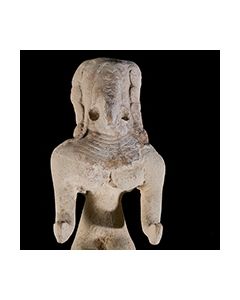 Idol - Figur der Harappa - Kultur
Idol - Figur der Harappa - KulturSehr rares Zeugnis einer der ältesten Stadtkulturen der Menschheit. Keramik-Figur einer Göttin, 3. bis 2. Jt. v. Chr.
Price: on request 32 seltene ägyptische Scheibenperlen aus Straußenei-Schalen
32 seltene ägyptische Scheibenperlen aus Straußenei-SchalenGruppe vorantiker Scheibenperlen. Prädynastische Zeit. Durchmesser um 13 mm. Exzellenter Zustand.
Price: on request Hand axe from Galilee
Hand axe from GalileeBig paleolithic hand axe. The universal stone age tool could be use as a borer or cutting tool. Around 500,000 to 200,000 BC.
Price: on request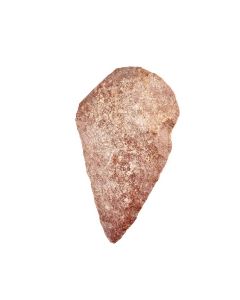 Paleolithic hand axe
Paleolithic hand axeThe universal tool of the older Stone age. It could be used as a borer or a cutter. Approx. 500,000 to 200,000 BC.
Price: on request Cypriot amphora from the famous Severis collection
Cypriot amphora from the famous Severis collectionEx Fortnum and Mason, London, UK. Impressive piece.
Price: on request Weibliches Idol der Harappa-Kultur
Weibliches Idol der Harappa-KulturFigur in perfektem Zustand. Volgeartiges Gesicht, aufwändiges Kollier mit Amulett um den Hals. Vermutlich aus Baluchistan. Um 2000 v. Chr.
Price: on request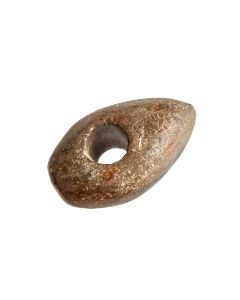 Small battle axe of the Single Grave culture
Small battle axe of the Single Grave cultureThe axe head from the younger Stone Age has a compact shape. Axes that have clearly been used as weapons are rare. Most axe types have probably served peaceful purposes.
Price: on request Speerspitze aus Lorestan
Speerspitze aus LorestanGroße luristanische Speerspitze mit Spuren von Kampfeinsatz. 2500 bis 1000 v. Chr., 185mm lang. Zeugnis der eigenständigen Kultur in der persischen Provinz Luristan.
Price: on request Mochica stirrup vessel
Mochica stirrup vesselThe body is creatively shaped as a bird man. A wonderful testimony to the last bloom of the Mochica culture before its collapse.
Price: on request Paleolithic hand axe of Homo Erectus
Paleolithic hand axe of Homo ErectusBig hand axe from Niger. Made during the Old Stone Age, around 200,000 years ago. The universal stone age tool could be use as a borer or cutting tool.
Price: on request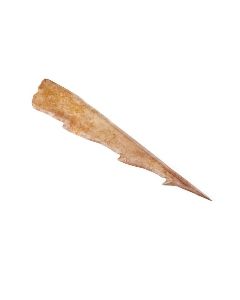 Harpoon of the Maglemosian culture
Harpoon of the Maglemosian cultureFine craftsmanship hunting weapon. Important evidence of the beginnings of fishing in Northern Europe. Mesolithic, 9000 to 6500 BC.
Price: on request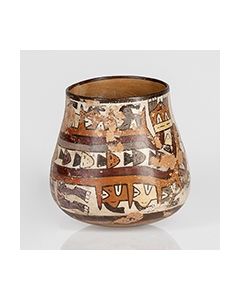 Beaker of the Nazca culture
Beaker of the Nazca cultureElegant vessel made by the precolumbian Nazca culture. The outside is decorated by a polychrome szene of geometric patterns and abstractions of animals and faces.
Price: on request Cypriot bowl from the famous Severis collection
Cypriot bowl from the famous Severis collectionPerfectly preserved piece with very vivid bichrome decoration. Ex Christie's.
Price: on request

